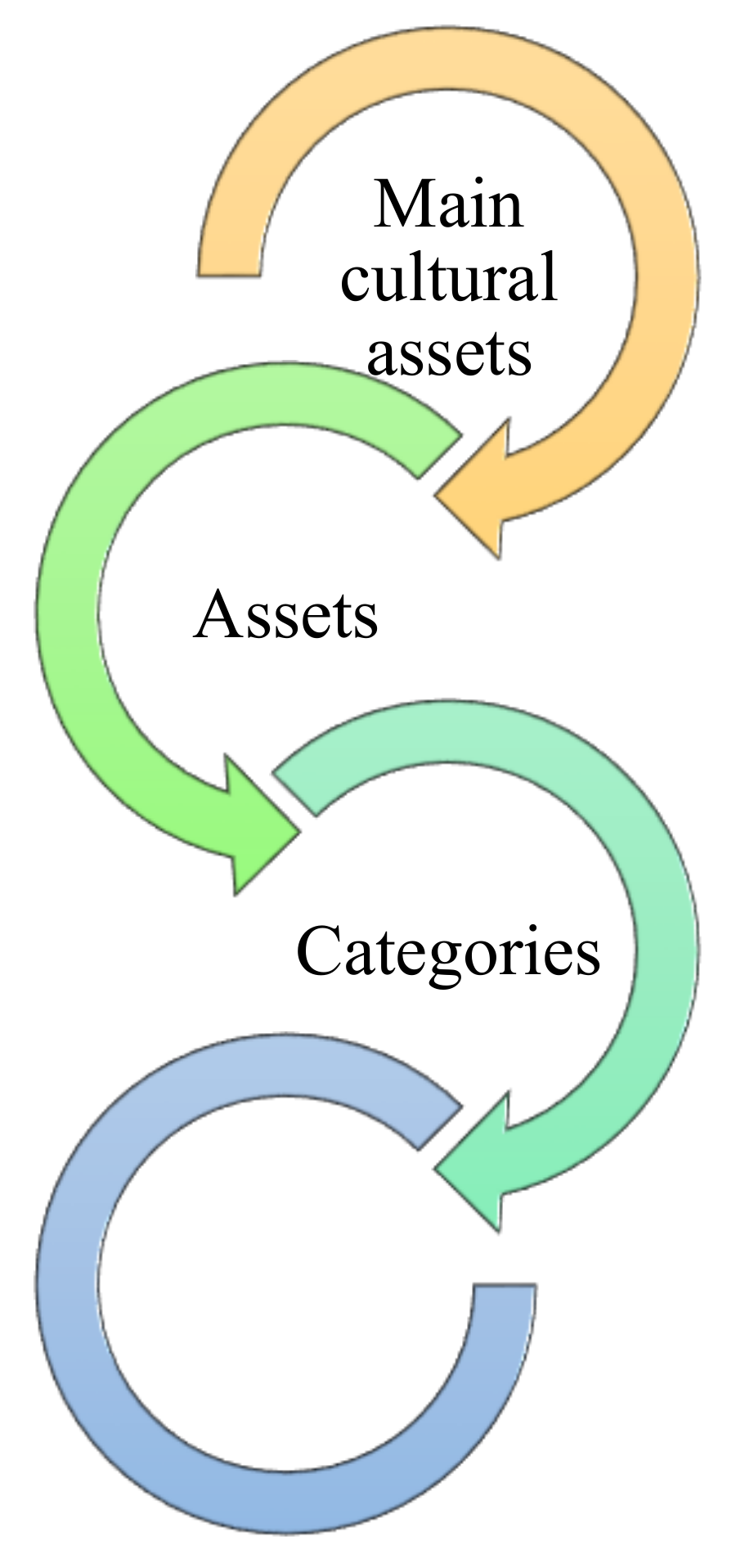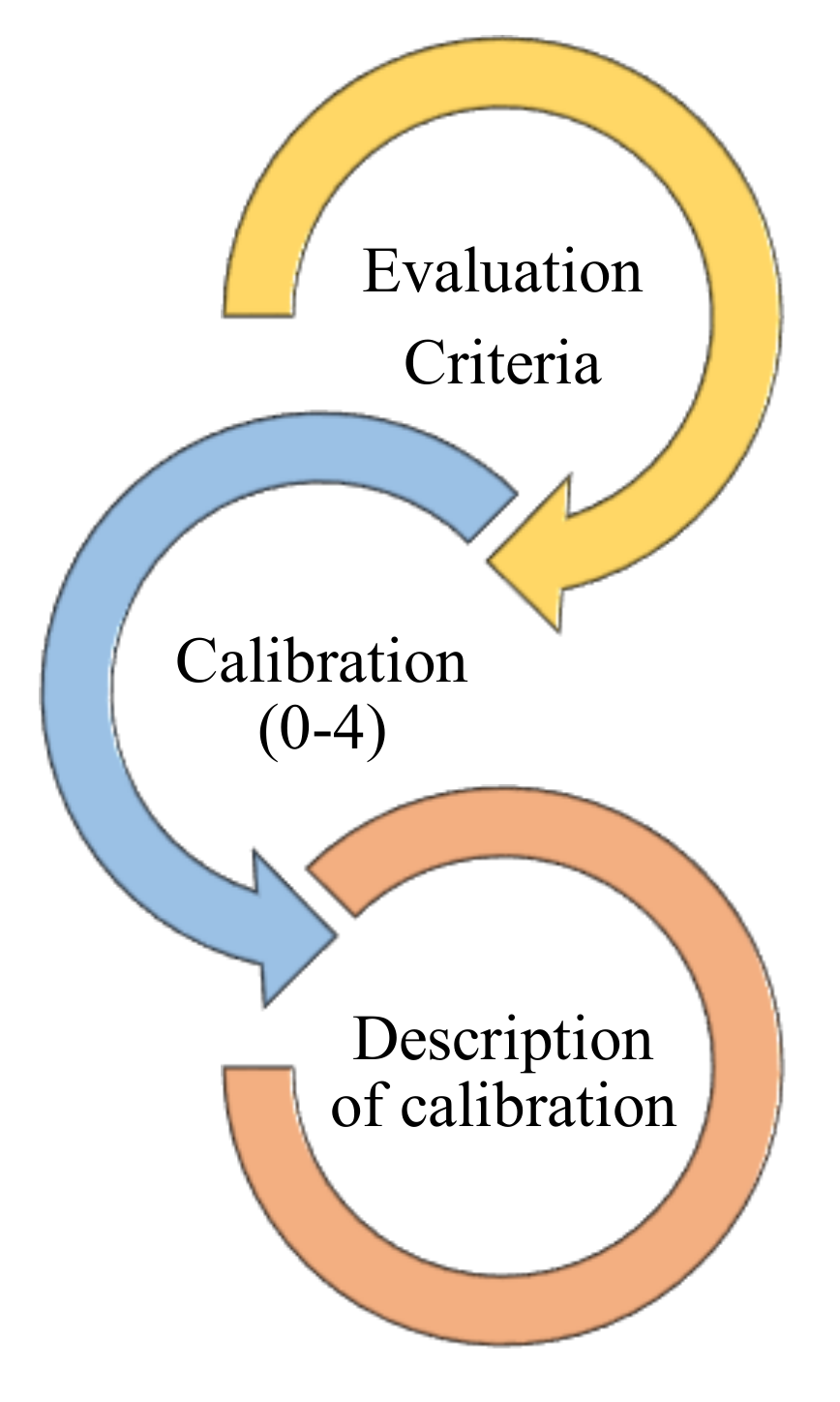Recording and Evaluating the Tangible and Intangible Cultural Assets of a Place through a Multicriteria Decision-Making System
Abstract
1. Introduction
2. Materials and Methods
3. Cultural Heritage and Place
3.1. Tangible and Intangible Cultural Heritage
3.2. Categories of the Cultural Assets of a Place
4. Development of the Multicriteria Decision-Making System
- Flora (average price: 4),
- Folklore music (average price: 3),
- Monument (average price: 2),
- Fauna (average price: 1).
5. Discussion
6. Conclusions
- The paper outlines an innovative solution for the protection and evaluation of the cultural heritage of places. In addition, these findings provide additional information about both tangible and intangible cultural assets.
- The value of our contribution lies in the proposed system. Our study provides the framework for a new way to evaluate the cultural heritage of each place, nationally and internationally. Additionally, this new evaluation system can be easily fulfilled and shared, among the respective users (governments, organizations, and ordinary users).
- Collectively, our results appear to be consistent with the evaluation criteria. The use of quantitative and qualitative criteria provides a powerful methodology for the evaluation of culture, as it describes new knowledge or ideas based on original research. The proposed research may provide a useful resource for future studies.
- Finally, the most important impact of the research is the creation of a new innovative multicriteria decision-making system. The broad implication of the present research is that it records and evaluates culture, and especially intangible culture, which so far has not be sufficiently studied, particularly at a scientific level.
Author Contributions
Funding
Conflicts of Interest
References
- Guzmán, P.; Roders, A.A.P.; Colenbrander, B.B. Measuring links between cultural heritage management and sustainable urban development: An overview of global monitoring tools. Cities 2017, 60, 192–201. [Google Scholar] [CrossRef]
- Giove, S. Economic forecasting with tangible and intangible criteria: The analytic hierarchy process of measurement and its validation, an application of Multicriteria Decision Making to build heritage: The case of Calcutta, Impact of culture on tourist decision-making styles. J. Multi-Criteria Decis. Anal. 2010, 17, 85–99. [Google Scholar]
- Jamal, T.; Hill, S. Developing a framework for indicators of authenticity: The place and space of cultural and heritage tourism, Long life monitoring of historical monuments via wireless sensors network. Asia Pac. J. Tour. Res. 2004, 9, 353–372. [Google Scholar] [CrossRef]
- Alexandri, E. Cultural heritage—Management. In Cultural Renaissance of 19th Century Athens; Ion: Athens, Greece, 2015. [Google Scholar]
- Papoulias, E. The Management of Cultural Heritage in Greece; Politia: Athens, Greece, 2012. [Google Scholar]
- Gialoura, A. Material culture: Anthropology in the Land of Things; Politia: Athens, Greece, 2012. [Google Scholar]
- Economou, A. Tangible Culture: Theory, Methodology, Exploitation; Papazisi: Athens, Greece, 2014. [Google Scholar]
- Kanelatou, A. UNESCO and Intangible Cultural Heritage: Critical Study Regarding the Inclusion of Data in the Hellenic National Depository; Postgraduate Work; Hellenic A-Open University: Athens, Greece, 2017. [Google Scholar]
- Korka, T. Intangible Cultural Heritage—Comparative Law Study; Sakkoulas: Athens, Greece, 2020. [Google Scholar]
- Tzavara, I. Intangible Cultural Heritage; Ministry of Culture and Tourism: Athens, Greece, 2018.
- Tsipis, F.S. Utilization of New Internet Technologies and Mobile Device Applications for the Promotion and promotion of the Intangible Cultural Heritage; Postgraduate Work; University of Patras: Patras, Greece, 2018. [Google Scholar]
- Ktori, M. Lefkara Lace: Educational Approaches to ICH in Cyprus. Int. J. Intang. Herit. 2020, 12. [Google Scholar]
- Aristeidou, A.; Stavrakis, E.; Chrysanthou, Y. Intangible cultural heritage: Recording of cypriot traditional dances and electronic ways of learning them. In Proceedings of the EUROMED Conference, Volos, Greece, 24–26 September 2015. [Google Scholar]
- Chatzigrigoriou, P. Development of a Multi-Criteria System of Digital Management of Remarkable Buildings and Ensembles Based on Data and GIS: The Case of the Historical Site of Ermoupolis. Ph.D. Thesis, National Technical University of Athens, Athens, Greece, 2013. [Google Scholar]
- Karadimou, G. Definition of landscape evaluation indicators of the Greek area. In Proceedings of the 10th International Geographical Conference, Thessaloniki, Greece, 7 November 2014. [Google Scholar]
- Bouchenaki, M. The interpedency of the tangible and intangible cultural heritage. In Proceedings of the ICOMOS 14th General Assembly and Scientific Symposium, Victoria Falls, Zimbabwe, 27–31 October 2003. [Google Scholar]
- Ruggles, F.; Silverman, H. From Tangible to Intangible Heritage; Springer: Berlin, Germany, 2009; pp. 131–142. [Google Scholar]
- Lenzerini, F. Intangible Cultural Heritage: The Living Culture of Peoples. Eur. J. Int. Law 2011, 22, 78–86. [Google Scholar] [CrossRef]
- Vecco, M. A definition of cultural heritage: From the tangible to the intangible. J. Cult. Herit. 2010, 11, 321–324. [Google Scholar] [CrossRef]
- Bottero, M. Evaluating Tangible and Intangible Aspects of Cultural Heritage: An Application of the PROMETHEE Method for the Reuse Project of the Ceva–Ormea Railway’: Integrated Evaluation for the Management of Contemporary Cities; Springer: Berlin, Germany, 2018; pp. 285–295. [Google Scholar]
- Dragonas, J.; Doulamis, A.; Ioannidis, C.; Klein, M.; Ioannides, M. Modelling of Static and Moving Objects: Digitizing Tangible and Intangible Cultural Heritage. Mix. Real. Gamification Cult. Herit. 2017, 3, 567–589. [Google Scholar] [CrossRef]
- Kioussi, M.; Karoglou, M.; Labropoulos, K.; Bakolas, A.; Moropoulou, A. Integrated documentation protocols enabling decision making in cultural heritage protection. J. Cult. Herit. 2013, 14, 141–146. [Google Scholar] [CrossRef]
- Scott, C. Measuring the immeasurable: Capturing intangible values. In Proceedings of the Marketing and Public Relations International Committee of ICOM (International Council of Museums), Brno, Czech Republic, 19 September 2011. [Google Scholar]
- Baglieri, M.; Chiesa, V.; Manzini, R.; Grando, A. Evaluating Intangible Assets: The Measurement of R&D Performance. SSRN Electron. J. 2001, 19, 23–38. [Google Scholar]
- Bruschi, V.M.; Cendrero, A. Geosite evaluation: Can we measure intangible values. Ital. J. Quat. Sci. 2005, 18, 291–304. [Google Scholar]
- Ioannides, M.; Athanasiou, V.; Chatzigrigoriou, P.; Papageorgiou, E.; Leventis, G.; Nikolakopoulou, V.; Sovis, C. Immersive Digital Heritage Experience with the Use of Interactive Technology; Springer: Berlin, Germany, 2016; pp. 43–52. [Google Scholar]
- O’Lear, S.; Diehl, P.F.; Frazier, D.V.; Allee, T.L. Dimensions of territorial conflict and resolution: Tangible and intangible values of territory. GeoJournal 2005, 64, 259–261. [Google Scholar] [CrossRef]
- Severo, M.; Venturini, T. Intangible Cultural Heritage Webs Comparing national networks with digital methods. SAGE J. 2016, 18, 341–364. [Google Scholar] [CrossRef]
- Mamaloukos, S. Cultural Heritage: Sero Time; Hellenic Society of Enviroment and Culture: Athens, Greece, 2008. [Google Scholar]
- Moraitis, K. The Art of Landscape: A Cultural Overview of Modern Local Views and Conturations; Kallipos: Athens, Greece, 2015. [Google Scholar]
- Pikionis, D. Texts; National Bank Educational Foundation (MIET): Athens, Greece, 2014. [Google Scholar]
- Sinisoglou, N. Gnostic. Elements of Philosophy. Theophilos Kairis; Cairo Library: Alexandria, Egypt, 2008. [Google Scholar]
- Aykan, B. Patenting’ Karagöz: UNESCO, nationalism and multinational intangible herit-age. Int. J. Herit. Stud. 2015, 21, 949–961. [Google Scholar] [CrossRef]
- Harvey, D.C. Heritage Pasts and Heritage Presents: Temporality, meaning and the scope of herit-age studies. Int. J. Herit. Stud. 2001, 7, 319–338. [Google Scholar] [CrossRef]
- Antchak, V. City rhythms and events. Ann. Tour. Res. 2018, 68, 52–54. [Google Scholar] [CrossRef]
- Mylonopoulos, D. The International Protection of the World Natural Heritage in a Period of Hostilities; Law and Nature: Athens, Greece, 2007. [Google Scholar]
- Linaki, E. Intangible and Tangible Cultural Resources of Ano Syros. A Model Urban Study. Bachelor’s Thesis, Aristotle University of Thessaloniki, Thessaloniki, Greece, 2016. [Google Scholar]
- Stefanou, J. The Physiognomy of the Greek City; University Press, NTUA: Athens, Greece, 2000. [Google Scholar]
- Terzić, A.B.Z.; Ćurčić, N. Common Histories, Constructed Identities: Intangible Cultural Heritage and the Rebranding of Serbia. Int. J. Intang. Herit. 2015, 10, 101–124. [Google Scholar]
- Terkenli, T. The Cultural Landscape; Papazisi: Athens, Greece, 1996. [Google Scholar]
- Lavier, Z. Chinese Acupuncture: History, System, Practice; Fiery world: Athens, Greece, 1988. [Google Scholar]
- Harrison, R. Forgetting to remember, remembering to forget: Late modern heritage practic-es, sustainability and the ‘crisis’ of accumulation of the past. Int. J. Herit. Stud. 2013, 19, 579–595. [Google Scholar] [CrossRef]
- Ηeller, A. Cultural Memory, Identity and Civil Society; Academia: Leeds, UK, 2001; pp. 139–143. [Google Scholar]
- UNESCO. Text of the Convention for the Safeguarding of the Intangible Cultural Heritage; UNESCO: Paris, France, 2003. [Google Scholar]
- Pocock, C.; Collett, D.; Baulch, L. Assessing Stories before Sites: Identifying the Tangible from the Intangible, School of Arts and Communication. Master’s Thesis, University of Southern Queensland, Toowoomba, Australia, 2014. [Google Scholar]
- Solanilla, L. The Internet as a Tool for Communicating Life Stories: A New Challenge for “Memory Institutions”. Intag. Herit. 2008, 3, 45–49. [Google Scholar]
- Nijkamp, P. A Survey of Methodes for Sustainable City Planning and Cultural Heritage Management; Research Memorandum; Serie Research Memoranda 0050; VU University Amsterdam, Faculty of Economics, Business Administration and Econometrics: Amsterdam, The Netherlands, 1998; p. 50. [Google Scholar]
- Klopp, J.; Petretta, D. The urban sustainable development goal: Indicators, complexity and the politics of measuring cities. Cities 2017, 63, 92–97. [Google Scholar] [CrossRef]
- Turban, E. Decision Support and Expert Systems: Management Support System, 4th ed.; Prentice Hall (Higher Education Division, Pearson Education): Upper Saddle River, NJ, USA, 3 February 1995. [Google Scholar]
- Sainfort, S.; Gustafson, D.; Bosworth, K.; Hawkins, R.P. Decision Support Systems Effectiveness: Conceptual Framework and Empirical Evaluation. Organ. Behav. Hum. Decis. Process. 1990, 45, 232–235. [Google Scholar] [CrossRef]
- Kailiponi, P. Analyzing evacuation decisions using multi-attribute utility theory (MAUT). Procedia Eng. 2010, 3, 163–174. [Google Scholar] [CrossRef]
- Scholz, M.; Franz, A.; Hinz, O. Effects of decision space information on MAUT-based systems that support purchase decision processes. Decis. Support Syst. 2017, 97, 43–57. [Google Scholar] [CrossRef]





| Assets | Categories |
|---|---|
| Natural assets | 1. Morphology |
| 2. Blue surfaces | |
| 3. Biodiversity |
| Main Cultural Assets | Assets | Categories | Record |
|---|---|---|---|
| Tangible cultural assets | Natural assets | Biodiversity | Flora |
| Record | Evaluation Criteria |
|---|---|
| Flora | 1. Level of maintenance of the initial existence of species |
| 2. Existence of important habitats | |
| 3. Uniqueness of protected species | |
| 4. Variety of species | |
| 5. Connection with the history and tradition of the place |
| Record | Evaluation Criteria | Description of Calibration | Selection from 0–4 |
|---|---|---|---|
| Flora | 1. Variety of species | 0: Up to 10 different species of flora are identified | 0 (random value) |
| 1: Up to 20 different species of flora are identified | |||
| 2: Up to 50 different species of flora are identified | |||
| 3: Up to 100 different species of flora are identified | |||
| 4: More than 100 different species of flora are identified |
| Record | Evaluation Criteria | Selection from 0–4 |
|---|---|---|
| Flora | 0: Up to 10 different species of flora are identified | 0 |
| 1: Up to 20 different species of flora are identified | 3 | |
| 2: Up to 50 different species of flora are identified | 2 | |
| 3: Up to 100 different species of flora are identified | 2 | |
| 4: More than 100 different species of flora are identified | 3 |
Publisher’s Note: MDPI stays neutral with regard to jurisdictional claims in published maps and institutional affiliations. |
© 2020 by the authors. Licensee MDPI, Basel, Switzerland. This article is an open access article distributed under the terms and conditions of the Creative Commons Attribution (CC BY) license (http://creativecommons.org/licenses/by/4.0/).
Share and Cite
Linaki, E.; Serraos, K. Recording and Evaluating the Tangible and Intangible Cultural Assets of a Place through a Multicriteria Decision-Making System. Heritage 2020, 3, 1483-1495. https://doi.org/10.3390/heritage3040082
Linaki E, Serraos K. Recording and Evaluating the Tangible and Intangible Cultural Assets of a Place through a Multicriteria Decision-Making System. Heritage. 2020; 3(4):1483-1495. https://doi.org/10.3390/heritage3040082
Chicago/Turabian StyleLinaki, Eleni, and Konstantinos Serraos. 2020. "Recording and Evaluating the Tangible and Intangible Cultural Assets of a Place through a Multicriteria Decision-Making System" Heritage 3, no. 4: 1483-1495. https://doi.org/10.3390/heritage3040082
APA StyleLinaki, E., & Serraos, K. (2020). Recording and Evaluating the Tangible and Intangible Cultural Assets of a Place through a Multicriteria Decision-Making System. Heritage, 3(4), 1483-1495. https://doi.org/10.3390/heritage3040082




